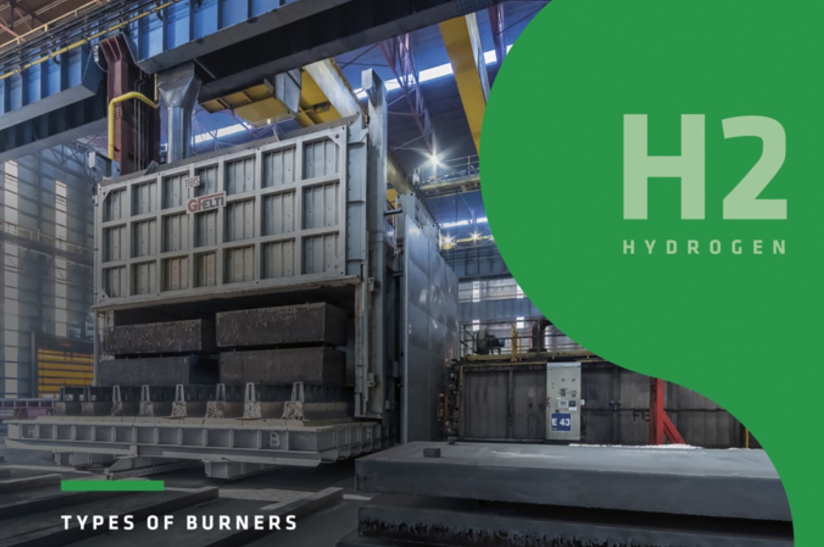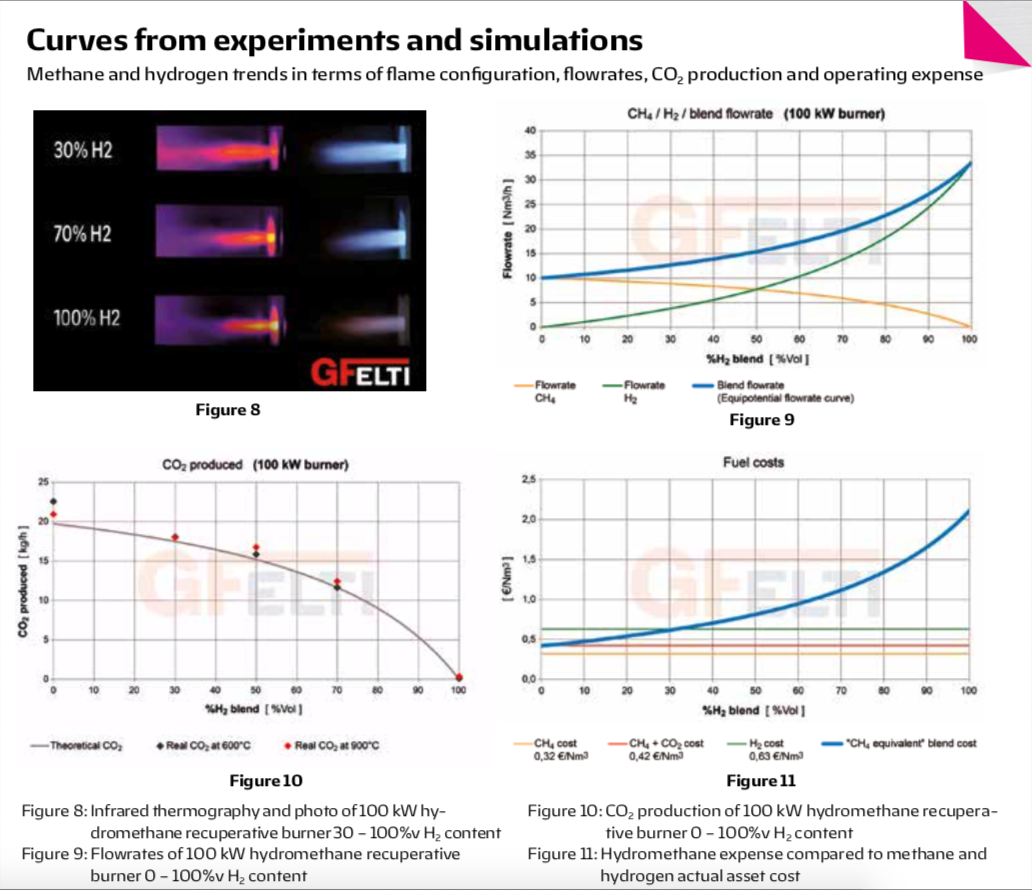Firstly, thermal camera captures analyses were taken to study how hy- drogen affects combustion. The impacts in temperature boost at flame generation point and flame length can be appreciated in Figure 8 on the left. Higher flame temperature determines some increment in NOx generation. To tackle this side effect burners manufacturers shall adopt appropriate practices to limit emission. In this regard, GF-ELTI is collecting data for evidence and further publications. Hydrogen content (i.e. 30 – 100%v) has also effects in terms of flame visibility. Blue flames on the right-hand side of Figure 8 are photos shot during the experiment.
Burner flowrate requirement has interesting outcomes. As previously stated, burner power output is constant, therefore whatever selected blend must comply with 100 kW set for recuperative burners and 300 kW for regenerative, respectively. Figure 9 refers to recuperative type. It shows on Y-axis volumetric flowrates and on X-axis volumetric H2 blend content. There are three main trends: methane flowrate in orange, hydrogen in green and hydromethane in blue. It is clear that hydrogen does not impact linearly on flowrate. Having hydrogen a smaller lower heating value, it compensates with more flowrate. For instance, one 100 kW burner running 100%v on methane requires 10 Nm3/h of CH4. The same power output with hydrogen requires 33 Nm3/h. It is 3,35 times that of methane.
Hydrométhane combustion and CO2 behaviour
Some environmental considerations could not be left outside this paper. Hence, furnaces were equipped with CO2 emission detecting systems. The values were registered during test at different percentages of hydrogen. Figure 10 resumes CO2 emission from both theoretical and practical point of view. Y-axis illustrates the amount of carbon dioxide production in kg/h and X-axis volumetric hydrogen blend content.
Having 0%v H2 means running 100% on methane, likewise 0 kg/h CO2 production equals to operate hydromethane 100%v H2. The grey curve represents theoretical trend, while black and red points are the measurements during tests at 600 °C and 900 °C. Experimental outcomes compared with theoretical CO2 productions indicate that there is accuracy between measurements. It is interesting to highlight that temperatures do not affect CO2 production rates.
Hydrométhane economic evaluations
Operating expense is another essential indicator. It could not be neglected. Despite being subject to changes (i.e. fluctuations due to pandemic), energy prices offer meaningful information. Figure 11 provides an insight on fuels trend cost. Y-axis shows costs in €/Nm3 and X-axis volumetric H2 blend content. There are three horizontal lines: they represent cost hypothesis at the time of the experiment (i.e. early August 2021). From highest to lowest price: 0,63 €/Nm3 for hydrogen, 0,42 €/Nm3 for methane plus taxation (i.e. 53 €/t) for CO2 production and emission as per Emission Trading Scheme regulation, and 0,32 €/Nm3 for pure methane. The blue line represents hydromethane cost energetically equivalent to methane to operate at the same power. For example, running a burner 100%v H2 is approximately five times more expensive than pure methane ( 2,11 €/Nm3 for H2 against 0,42 €/Nm3 for CH4).
Conclusions
The promising capabilities of H2Burn technology are demonstrated by a solution able to operate on high-efficiency recuperative and regenerative type burners. Their powering can be done either by a combination of methane and hydrogen or by pure hydrogen. Needless to say that, in case of hydrogen shortages, H2burn can operate with pure methane. Hence, it can help steel industry carbon footprint optimization anytime.
Despite the presence of little guidelines on the matter, GF-ELTI managed to implement stable test configurations and to generate experimental results. Technical set up and its criticalities have been managed by adequate selection of components. It is reasonable to believe that market will make these elements more available in future.
Further experiments will take place to complete the analysis. Focus will be on continuous use of hydrogen for steel heating applications. It is essential to continue the research on high-efficiency technologies to facilitate the promotion of energy saving practices. Even though there is still some reluctance on this regard, benefits of using efficient combustion is indisputable. Higher investment costs see their premium price mitigated on the long run. This trend is boosted even more today with the rising costs of fuel and electricity.
Green hydrogen can contribute to draw more attention to energy efficiency. If hydrogen succeeds, that time should be soon. The “1 1 1” slogan of the U.S. Department of Energy’s (DOE’s) states that clean green hydrogen cost shall be reduced by 80% from $5 to $1 per 1 kilogram in 1 decade [7]. It is undoubtedly a challenging target.
At present (i.e. August 2021) green hydrogen production on Italian market may be estimated 2,11 €/Nm3 equivalent to CH4 use. To make hydrogen as competitive as methane 0,32 €/Nm3 cost, some reduction strategies must occur. Assuming to halve electricity cost thanks to a penetration of renewables from 0,14 €/kWh to 0,07 €/kWh and to boost hydrogen production efficiency up to 95%, green hydrogen would still be more expensive than methane. Approximately, 0,70 €/Nm3 against 0,32 €/Nm3. Further cost compensations would be necessary. Forecasting methane prices after a pandemic is not an easy, therefore this thinking exercise concludes assuming only that policy makers tighten the Emission Trading Scheme. The necessary amendments would be tremendous and methane taxation should rise from 53 €/t to 195 €/t of CO2 produced. The reason of this final exercise is to highlight what should happen today to get competitive hydrogen for combustion [6].
References:
[1] IEA. The future of hydrogen. Paris, FR: International Energy Agency; 2019
[2] Hydrogen Europe. Hydrogen safety. Brussels, BE: Hydrogen Europe; 2020
[3] McCarty, R. D., J. Hord, and H. M. Roder, Selected Properties of Hydrogen (Engineering Design Data), NBS Monograph 168, National Bureau of Standards, Boulder, CO (1981).
[4] Carcassi, M N. Semi-empirical correlations for the burning velocity of hydrogen-air vented deflagrations. Canada: N. p., 1990. Web.
[5] ISO/TC 197 Hydrogen Technologies
[6] Teani, M., Carcassi, M N. H2Burn Technology: High-efficiency burners for the energy transition. Milan, IT: Made in Steel; 2021.
[7] US Department of Energy. Energy Earth shots. Washington DC, US: Energy efficiency and renewable energy; 202








